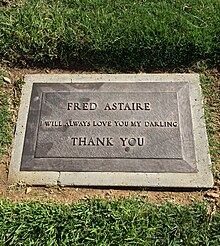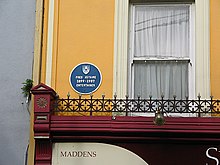Fred Astaire
Fred Astaire (born Frederick Austerlitz,[1] May 10, 1899 – June 22, 1987) was an American dancer, actor, singer, musician, choreographer, and presenter, whose career in stage, film, and television spanned 76 years.
[3] Astaire's fame grew in films like Holiday Inn (1942), Easter Parade (1948), The Band Wagon (1953), Funny Face (1957), and Silk Stockings (1957).
"[14] As a result of their father's salesmanship, Fred and Adele Astaire landed a major contract and played the Orpheum Circuit in the Midwest, West and some Southern cities in the U.S.
[15] The career of the Astaire siblings resumed with mixed fortunes, but with increasing skill and polish, as they began to incorporate tap dancing into their act.
They won popular acclaim with the theater crowd on both sides of the Atlantic in shows such as Jerome Kern's The Bunch and Judy (1922), George and Ira Gershwin's Lady, Be Good (1924), and Funny Face (1927) and later in The Band Wagon (1931).
"[22] While in London, Fred studied piano at the Guildhall School of Music alongside his friend and colleague Noël Coward,[23] and in 1926, was one of the judges at the 'Charleston Championship of the World ' competition at the Royal Albert Hall, where Lew Grade was declared the winner.
[22]: 23, 26 First, he insisted that a closely tracking dolly camera film a dance routine in as few shots as possible, typically with just four to eight cuts, while holding the dancers in full view at all times.
"[22]: 420 Astaire maintained this policy from The Gay Divorcee in 1934 until his last film musical, Finian's Rainbow in 1968, when director Francis Ford Coppola overruled him.
Those musicals' sequences were filled with extravagant aerial shots, dozens of cuts for quick takes, and zooms on areas of the body such as a chorus row of arms or legs.
While both films earned respectable gross incomes, they both lost money because of increased production costs,[22]: 410 and Astaire left RKO after being labeled "box office poison" by the Independent Theatre Owners of America.
[40] Always insecure and believing his career was beginning to falter, Astaire surprised his audiences by announcing his retirement during the production of his next film, Blue Skies (1946).
He returned to the big screen to replace an injured Gene Kelly in Easter Parade (1948) opposite Judy Garland, Ann Miller, and Peter Lawford.
Royal Wedding (1951) with Jane Powell and Peter Lawford proved to be very successful, but The Belle of New York (1952) with Vera-Ellen was a critical and box-office disaster.
[citation needed] Soon after, Astaire, along with most of the other remaining stars at MGM, was dismissed by the studio due to the advent of television and the streamlining of film production.
Astaire's next film, Silk Stockings (1957), in which he co-starred with Cyd Charisse and his final musical for MGM, also lost money at the box office.
[citation needed] In 1978, he co-starred with Helen Hayes in a well received television film A Family Upside Down in which they played an elderly couple coping with failing health.
He made a well publicized guest appearance on the science-fiction television series Battlestar Galactica in 1979, as Chameleon, the possible father of Starbuck, in "The Man with Nine Lives", a role written for him by Donald P. Bellisario.
Astaire asked his agent to obtain a role for him on Galactica because of his grandchildren's interest in the series and the producers were delighted at the opportunity to create an entire episode to feature him.
Long after the photography for the solo dance number "I Wanna Be a Dancin' Man" was completed for the 1952 feature The Belle of New York, it was decided that Astaire's humble costume and the threadbare stage set were inadequate and the entire sequence was reshot.
As Jerome Robbins stated, "Astaire's dancing looks so simple, so disarming, so easy, yet the understructure, the way he sets the steps on, over or against the music, is so surprising and inventive.
[citation needed] Frequently, a dance sequence was built around two or three key ideas, sometimes inspired by his steps or by the music itself, suggesting a particular mood or action.
He first presented Jerome Kern's "The Way You Look Tonight" in Swing Time (1936), the Gershwins' "They Can't Take That Away from Me" in Shall We Dance (1937), "A Foggy Day" and "Nice Work if You Can Get it" in A Damsel in Distress (1937), Johnny Mercer's "One for My Baby" from The Sky's the Limit (1943), "Something's Gotta Give" from Daddy Long Legs (1955); and Harry Warren and Arthur Freed's "This Heart of Mine" from Ziegfeld Follies (1946).
For example, with his sister Adele, he co-introduced the Gershwins' "I'll Build a Stairway to Paradise" from Stop Flirting (1923), "Fascinating Rhythm" in Lady, Be Good (1924), "Funny Face" in Funny Face (1927), and, in duets with Ginger Rogers, he presented Irving Berlin's "I'm Putting All My Eggs in One Basket" in Follow the Fleet (1936), Jerome Kern's "Pick Yourself Up" and "A Fine Romance" in Swing Time (1936), along with the Gershwins' "Let's Call the Whole Thing Off" from Shall We Dance (1937).
With Judy Garland, he sang Irving Berlin's "A Couple of Swells" from Easter Parade (1948); and, with Jack Buchanan, Oscar Levant, and Nanette Fabray he delivered Arthur Schwartz's and Howard Dietz's "That's Entertainment!"
Although he possessed a light voice, he was admired for his lyricism, diction, and phrasing[55]—the grace and elegance so prized in his dancing seemed to be reflected in his singing, a capacity for synthesis which led Burton Lane to describe him as "the world's greatest musical performer".
[22]: 21 Irving Berlin considered Astaire the equal of any male interpreter of his songs—"as good as Jolson, Crosby or Sinatra, not necessarily because of his voice, but for his conception of projecting a song.
[62] Astaire attempted to drop out of the film Daddy Long Legs (1955), offering to pay the production costs to date, but was persuaded to stay.
[74] Astaire remained a male fashion icon even into his later years, eschewing his trademark top hat, white tie, and tails, which he hated.
[75] Instead, he favored a breezy casual style of tailored sport jackets, colored shirts, and slacks—the latter usually held up by the distinctive use of an old tie or silk scarf in place of a belt.
[77] He starred in numerous musical films such as The Gay Divorcee (1934), Top Hat (1935), Follow the Fleet (1936), Swing Time (1936), Shall We Dance (1937), Holiday Inn (1952), Easter Parade (1948), The Barkleys of Broadway (1949), Royal Wedding (1951), The Band Wagon (1953), Funny Face (1957), Silk Stockings, Finian's Rainbow (1968).













